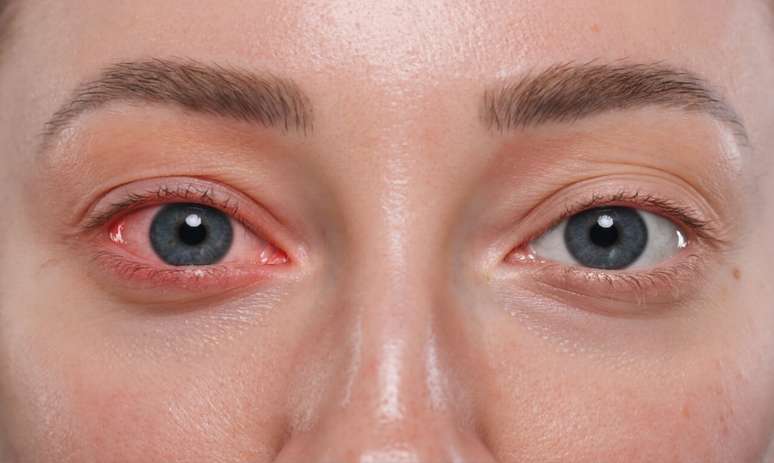Low temperatures and other features of the season reduce immunity and increase the circulation of viruses, such as conjunctivitis
Next Wednesday (6/20) we will officially enter winter, a season in which various pathologies become more frequent, including viral conjunctivitis. To protect yourself from the disease in the coming months it is important to adopt prevention measures.
According to ophthalmologist Leôncio Queiroz Neto of the Penido Burnier Institute, the cold is the ideal environment for the reproduction of different strains of viruses, such as adenovirus. Causes some types of colds and conjunctivitis, inflammation of the conjunctiva. That is, the transparent membrane that covers the eyelids and sclera, the white part of the eyes.
The expert underlines that the increase in pollution in the winter period causes dry eyes, a dysfunction in the quantity or quality of tears, which have the function of protecting the eyes.
“Without this barrier against external aggressions, the virus reaches the eyes through the air, water, contact with the secretions of a cold person or from the hand to the eyes after touching a contaminated object,” he explains.
Symptoms of conjunctivitis
The first symptoms of conjunctivitis usually appear in the morning, upon waking, and include:
- Eye pain;
- Burning;
- Sensation of sand in the eyes;
- Blurred vision;
- Viscous secretion;
- Swollen eyelids.
Furthermore, those with a low immune system may also experience cold symptoms: cough, runny nose and sore throat.
How is conjunctivitis transmitted?
Both viral and bacterial conjunctivitis are highly contagious. Transmission occurs through contact with eye secretions or surfaces touched by the infected person.
They therefore constitute an important cause of absence from work and school. Furthermore, avoiding schools, workplaces and other closed environments is crucial to recovering from the condition and not increasing the number of cases.
Groups with greater predisposition
Queiroz Neto says that all age groups can contract viral conjunctivitis. However, four groups are more predisposed:
- Children, like many, have never had previous contact with the virus and therefore have no natural immunity.
- Young students and workers who remain crammed at home every day.
- Elderly, allergy sufferers, postmenopausal women and immunocompromised people, who have greater tear deficiency.
These groups, explains Leôncio, can develop keratoconjunctivitis. The condition is characterized by infiltrates in the cornea that cause areas of cloudiness, which can permanently impair vision if adequate treatment is not received.
Treatment
Viral conjunctivitis usually lasts two weeks. When there are no infiltrates, the indication is to instill lubricating eye drops to reduce discomfort, explains the ophthalmologist.
In case of keratoconjunctivitis, treatment is with eye drops containing corticosteroids. This case, however, requires monitoring by an ophthalmologist to be removed gradually and not cause a rebound effect, emphasizes Leônio.
Also, according to him, a frequent mistake in the treatment of viral conjunctivitis is the use of antibiotic eye drops. This is because the antibiotic worsens the condition and, if used indiscriminately, causes resistance to the drug.
Prevention
Leôncio gives 9 tips to prevent viral conjunctivitis. Watch:
- Avoid crowds in closed places;
- Keep your eyes lubricated;
- Wash your hands often;
- Avoid touching your eyes with your hands;
- At the first discomfort, immediately consult an ophthalmologist;
- Stop using contact lenses until your eye has fully recovered;
- Sleep well;
- Apply a cold compress made with gauze and filtered water;
- Never share eye drops, pillowcases, towels and makeup.
Source: Terra
Ben Stock is a lifestyle journalist and author at Gossipify. He writes about topics such as health, wellness, travel, food and home decor. He provides practical advice and inspiration to improve well-being, keeps readers up to date with latest lifestyle news and trends, known for his engaging writing style, in-depth analysis and unique perspectives.





![More beautiful life in advance: What awaits you on Tuesday 14, 2025 on Tuesday, October 14 in 441 episodes [SPOILERS] More beautiful life in advance: What awaits you on Tuesday 14, 2025 on Tuesday, October 14 in 441 episodes [SPOILERS]](https://fr.web.img5.acsta.net/img/6b/c3/6bc3aa68e4679ab288217fa4c5dc825e.jpg)


